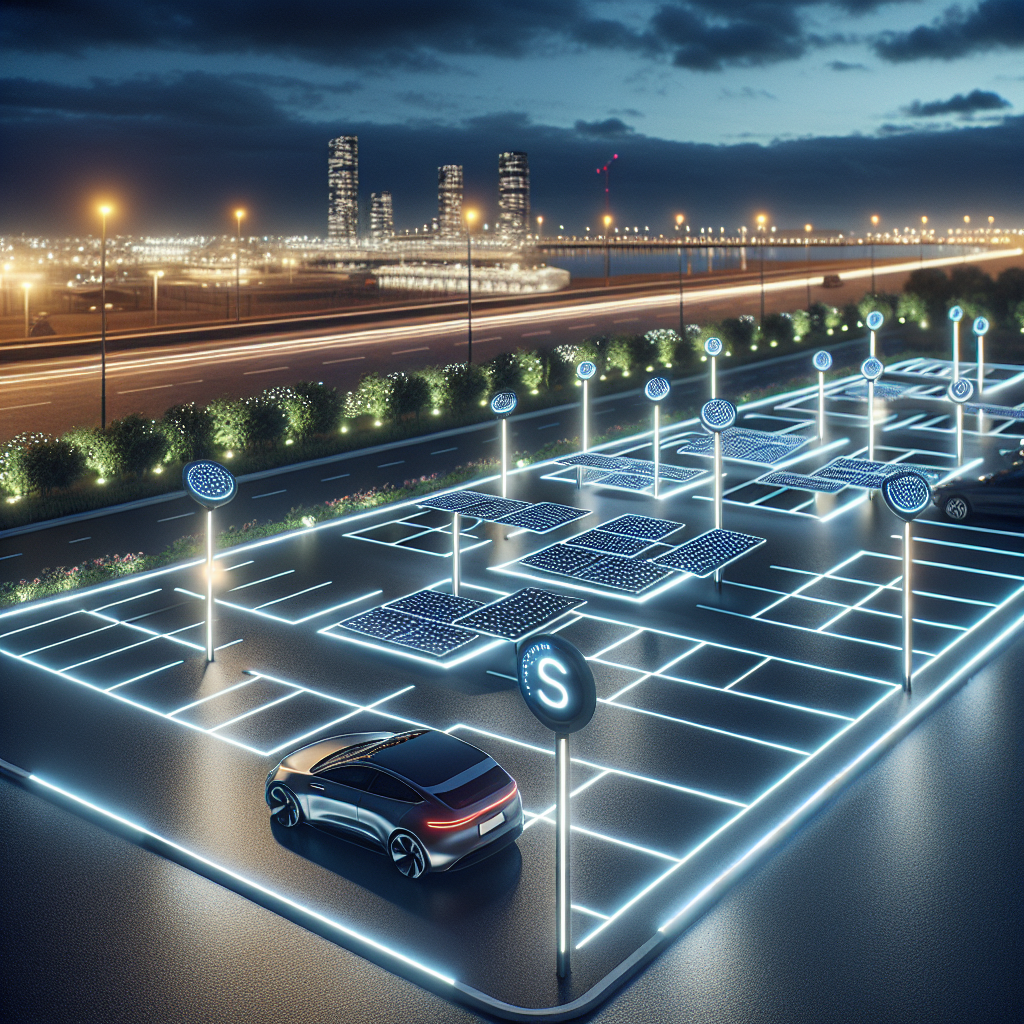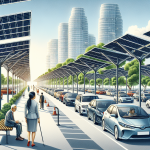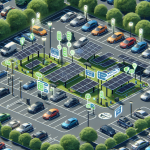Future Developments in Solar Carpark Lights
-
Table of Contents
Future developments in solar carpark lights are poised to revolutionize the way we illuminate parking areas, combining sustainability with advanced technology. As the demand for eco-friendly and energy-efficient solutions grows, solar carpark lights are evolving to incorporate cutting-edge innovations such as enhanced photovoltaic cells, energy storage systems, and smart technology integration. These advancements aim to increase the efficiency and reliability of solar lighting systems, ensuring consistent performance even in adverse weather conditions. Additionally, the integration of IoT (Internet of Things) and AI (Artificial Intelligence) will enable real-time monitoring and adaptive lighting controls, optimizing energy usage and maintenance. The future of solar carpark lights promises not only to reduce carbon footprints and operational costs but also to enhance safety and user experience in parking facilities worldwide.
Innovations in Solar Panel Efficiency for Carpark Lighting
The realm of solar carpark lights has witnessed significant advancements in recent years, driven by the imperative to enhance energy efficiency and sustainability. One of the most notable innovations in this domain is the improvement in solar panel efficiency, which has profound implications for carpark lighting systems. As solar technology continues to evolve, the efficiency of solar panels has become a focal point, with researchers and manufacturers striving to maximize the energy conversion rates of these panels.
To begin with, the efficiency of solar panels is a critical determinant of their performance. Higher efficiency panels can convert more sunlight into usable electricity, thereby reducing the number of panels required to power a given area. This is particularly advantageous for carpark lighting, where space constraints and aesthetic considerations often limit the number of panels that can be installed. Recent advancements in photovoltaic technology have led to the development of panels with efficiency rates exceeding 20%, a significant improvement over earlier models. These high-efficiency panels are capable of generating more power from the same amount of sunlight, making them ideal for carpark lighting applications.
Moreover, the integration of advanced materials and innovative designs has further propelled the efficiency of solar panels. For instance, the use of multi-junction cells, which layer different semiconductor materials to capture a broader spectrum of sunlight, has shown great promise. These cells can achieve higher efficiency rates by harnessing more of the sun’s energy compared to traditional single-junction cells. Additionally, the incorporation of bifacial panels, which can capture sunlight from both sides, has also contributed to enhanced energy generation. These technological advancements not only improve the performance of solar carpark lights but also reduce the overall cost of installation and maintenance.
In addition to material innovations, the optimization of panel orientation and tracking systems has played a crucial role in boosting solar panel efficiency. Fixed-tilt panels, while simpler and less expensive, do not always capture the maximum amount of sunlight throughout the day. In contrast, solar tracking systems, which adjust the angle of the panels to follow the sun’s trajectory, can significantly increase energy capture. Although these systems are more complex and costly, their ability to enhance efficiency makes them a worthwhile investment for large-scale carpark lighting projects.
Furthermore, the advent of smart technology has revolutionized the management and operation of solar carpark lights. Smart controllers and sensors can optimize the performance of the lighting system by adjusting the intensity of the lights based on real-time conditions, such as the presence of vehicles or pedestrians. This not only conserves energy but also extends the lifespan of the lighting components. Additionally, remote monitoring and control capabilities allow for proactive maintenance and troubleshooting, ensuring that the system operates at peak efficiency at all times.
As we look to the future, the continuous improvement in solar panel efficiency is expected to drive further innovations in carpark lighting. Emerging technologies, such as perovskite solar cells and organic photovoltaics, hold the potential to surpass the efficiency limits of current silicon-based panels. These next-generation materials promise to deliver even higher energy conversion rates while being more cost-effective and environmentally friendly.
In conclusion, the advancements in solar panel efficiency are poised to transform the landscape of carpark lighting. Through the integration of cutting-edge materials, innovative designs, and smart technology, solar carpark lights are becoming more efficient, reliable, and sustainable. As research and development in this field continue to progress, we can anticipate even greater strides in the efficiency and effectiveness of solar-powered lighting solutions, paving the way for a greener and more energy-efficient future.
Integration of Smart Technology in Solar Carpark Lights

The integration of smart technology in solar carpark lights represents a significant advancement in both renewable energy utilization and urban infrastructure management. As cities worldwide strive to become more sustainable, the adoption of solar-powered lighting systems in carparks is gaining momentum. These systems not only reduce reliance on non-renewable energy sources but also offer a myriad of benefits through the incorporation of smart technology.
One of the primary advantages of integrating smart technology into solar carpark lights is the enhancement of energy efficiency. Traditional lighting systems often operate on fixed schedules, leading to unnecessary energy consumption during periods of low activity. In contrast, smart solar carpark lights can be equipped with motion sensors and adaptive lighting controls. These features enable the lights to adjust their brightness based on real-time activity levels, thereby conserving energy when the carpark is empty and providing adequate illumination when it is occupied. This dynamic adjustment not only optimizes energy use but also extends the lifespan of the lighting components.
Moreover, the integration of smart technology facilitates remote monitoring and management of solar carpark lights. Through the use of Internet of Things (IoT) platforms, operators can access real-time data on the performance and status of each light. This capability allows for proactive maintenance, as issues such as battery degradation or panel obstructions can be identified and addressed promptly. Consequently, the reliability and efficiency of the lighting system are significantly improved, reducing downtime and maintenance costs.
In addition to operational efficiency, smart solar carpark lights contribute to enhanced safety and security. The ability to control lighting levels remotely means that carparks can be brightly illuminated during peak hours and dimmed during off-peak times, ensuring that users feel safe at all times. Furthermore, the integration of cameras and sensors can provide additional layers of security. For instance, motion-activated cameras can capture footage of any suspicious activity, while sensors can alert authorities to potential security breaches. This combination of lighting and surveillance technology creates a safer environment for carpark users.
Another noteworthy development is the potential for smart solar carpark lights to support electric vehicle (EV) charging infrastructure. As the adoption of electric vehicles continues to rise, the demand for convenient and accessible charging stations is increasing. By integrating EV charging capabilities into solar carpark lights, cities can provide a dual-purpose solution that leverages existing infrastructure. This approach not only maximizes the utility of solar carpark lights but also promotes the use of clean energy for transportation.
Furthermore, the data collected by smart solar carpark lights can be invaluable for urban planning and management. By analyzing patterns of carpark usage, city planners can make informed decisions about traffic flow, parking space allocation, and infrastructure development. This data-driven approach enables more efficient and effective urban planning, ultimately leading to smarter and more sustainable cities.
In conclusion, the integration of smart technology in solar carpark lights offers numerous benefits, ranging from improved energy efficiency and operational reliability to enhanced safety and support for electric vehicle infrastructure. As cities continue to embrace sustainability and smart technology, the adoption of these advanced lighting systems is likely to become increasingly prevalent. By harnessing the power of the sun and the intelligence of modern technology, solar carpark lights are poised to play a crucial role in the development of future urban landscapes.
Sustainable Materials and Design Trends in Solar Carpark Lighting
The evolution of solar carpark lights has been marked by significant advancements in both technology and design, driven by the increasing demand for sustainable and energy-efficient solutions. As the world continues to grapple with the challenges of climate change and resource depletion, the focus on sustainable materials and innovative design trends in solar carpark lighting has never been more pertinent. This article delves into the future developments in this field, highlighting the key trends and materials that are set to shape the landscape of solar carpark lighting.
One of the most notable trends in the development of solar carpark lights is the shift towards the use of sustainable materials. Traditional lighting systems often rely on materials that are not environmentally friendly, such as plastics and metals that require extensive mining and processing. In contrast, the future of solar carpark lighting is leaning towards the use of biodegradable and recyclable materials. For instance, bioplastics derived from renewable sources such as corn starch and sugarcane are being explored as alternatives to conventional plastics. These materials not only reduce the environmental impact but also contribute to the circular economy by being fully recyclable at the end of their lifecycle.
In addition to sustainable materials, the design of solar carpark lights is also undergoing a transformation. Modern designs are increasingly incorporating elements that enhance both functionality and aesthetics. One such trend is the integration of smart technology into solar carpark lights. Smart solar lights can be equipped with sensors that detect motion and adjust the lighting intensity accordingly, thereby conserving energy and extending the lifespan of the lights. Furthermore, these smart systems can be connected to a central management platform, allowing for remote monitoring and control. This not only improves the efficiency of the lighting system but also reduces maintenance costs.
Another design trend that is gaining traction is the use of modular systems. Modular solar carpark lights consist of interchangeable components that can be easily replaced or upgraded. This design approach not only simplifies maintenance but also allows for greater flexibility in adapting to changing needs and technological advancements. For example, as more efficient solar panels and batteries become available, they can be seamlessly integrated into the existing modular system without the need for a complete overhaul.
Moreover, the aesthetic aspect of solar carpark lights is also being given due consideration. Designers are increasingly focusing on creating lighting solutions that blend seamlessly with the surrounding environment. This involves the use of sleek and minimalist designs that enhance the visual appeal of carparks while providing adequate illumination. Additionally, the incorporation of natural elements such as wood and stone into the design of solar carpark lights is becoming more common, further emphasizing the commitment to sustainability.
Furthermore, the future of solar carpark lighting is also being shaped by advancements in photovoltaic technology. The development of more efficient and cost-effective solar panels is enabling the production of solar carpark lights that can generate more energy from the same amount of sunlight. This is particularly important in regions with limited sunlight, where maximizing energy capture is crucial. Additionally, innovations in energy storage, such as the use of advanced lithium-ion batteries, are ensuring that solar carpark lights can provide reliable illumination even during periods of low sunlight.
In conclusion, the future developments in solar carpark lights are being driven by a combination of sustainable materials, innovative design trends, and advancements in technology. As the world continues to prioritize sustainability, the evolution of solar carpark lighting is set to play a crucial role in reducing energy consumption and minimizing environmental impact. By embracing these trends and materials, we can look forward to a future where carparks are not only well-lit but also contribute positively to the environment.
Read more about Solar Carpark Lights:
- Introduction to Solar Carpark Lights
- Types of Solar Carpark Lights
- Factors to Consider when Choosing Solar Carpark Lights
- Installation and Maintenance of Solar Carpark Lights
- Top Brands in the Solar Carpark Light Industry
- Innovative Features of Solar Carpark Lights
- Case Studies: Successful Implementation of Solar Carpark Lights
- Practical Applications of Solar Carpark Lights
- Future Developments in Solar Carpark Lights
- Frequently Asked Questions about Solar Carpark Lights









